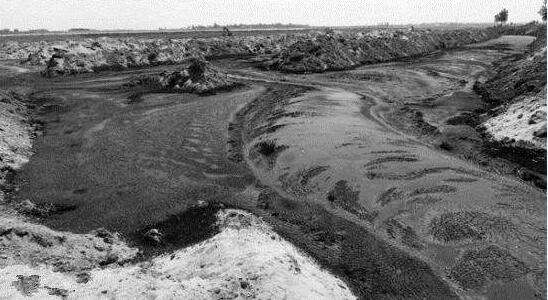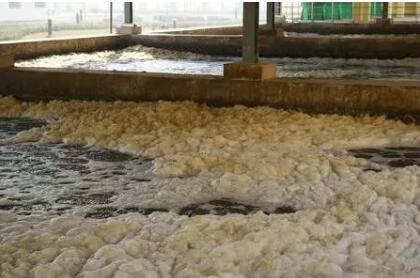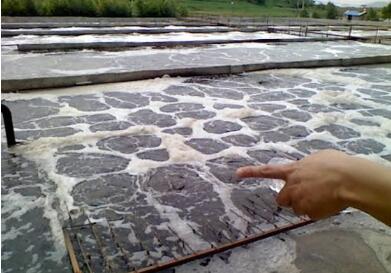At present, most urban sewage treatment plants around the world use activated sludge treatment. One of the common problems is that the microorganisms in activated sludge will be affected by various internal and external factors to reduce the proportion of activated sludge and float away, which not only increases the amount of suspended solids in the effluent, but also greatly reduces the biological reaction system. Activity and quantity of medium activated sludge. It makes the operation, operation and control of the sewage treatment plant have certain difficulties, which seriously affects the quality of the effluent water.
Causes of activated sludge floating
The causes of activated sludge floating can be roughly divided into two categories: one is caused by changes in the quality of the incoming water, and the other is caused by process operation control.
Influent water quality causes activated sludge to float
1. Excessive surface active substances and grease compounds
When normal sewage enters the aeration tank and operates, the partial degradation of organic substances by specific surfactants forms foams, and the foams grow rapidly. These foams are generally white and lightweight and disappear when the activated sludge reaches maturity. When there is an excessive amount of surface-active substances in the sewage, such substances can affect the stability and permeability of the plasma membrane of the cell, causing the loss of certain necessary components of the cell, resulting in stagnation and death of microorganisms. A large amount of foam (bubbles) is generated during aeration, and these bubbles are easily agglomerated on the bacterial micelles, which reduces the specific gravity of the activated sludge and floats. In addition, when the intake water contains too much oil and fat, after aeration and mixing, the oil and fat will agglomerate on the surface of the bacterial micelles, causing the bacteria to die of hypoxia, resulting in a decrease in specific gravity and floating.
2. PH shock
Too high or too low pH will affect the catalytic action of extracellular enzymes and enzymes present in the cytoplasm and cell wall of active sludge microorganisms, and the absorption of nutrients by microorganisms. When the pH of the continuous-flow aeration reaction tank is <4.0 or pH> 11.0, the microbial activity in the activated sludge is inhibited, lost, or even died in most cases, causing the sludge to float.
3. Influence of water temperature and salt content
The suitable temperature range of the microorganisms that make up the activated sludge is generally 15 ~ 35 ℃. Above 45 ℃, most of the microorganisms in the activated sludge will die and float (except after long-term domestication or special microorganisms).
Adjusting the pH value of the incoming water cannot eliminate the effect of alkalinity on activated sludge. The pH value of the alkaline influent was adjusted, and although the alkaline substance was neutralized, salt was generated. The osmotic pressure varies with the salt solution concentration. Osmotic pressure is one of the important factors affecting the survival of microorganisms. If the osmotic pressure of the solution in which the microorganisms are mutated, it will cause cell death.
4. Toxic substrates
Substrates that are toxic to aerobic activated sludge microorganisms include: COD, organic matter (phenols and their derivatives, alcohols, aldehydes and certain organic acids), sulfides, heavy metals and halides with excessive levels. High substrate concentrations can form stable compounds with active centers of cellular enzymes, causing the matrix to be inaccessible, unable to be degraded, and even cell poisoning to death. After entering into human cells, heavy metal ions mainly bind to -SH groups on enzymes or proteins to inactivate or denature them.
Trace amounts of heavy metal ions can also accumulate in cells and eventually cause toxic effects on microorganisms (micro-action). The most common halides are iodine and chlorine. Iodine irreversibly combines with the tyrosine of the bacterial protein (or enzyme) to form diiodotyrosine, which inactivates the bacterial body. Chlorine and water synthesize hypochlorous acid, which decomposes to produce a strong oxidant. In addition, the mutation of the organic matter in the wastewater reduces or eliminates the microorganisms that have been domesticated and can degrade organic poisons.
Floating activated sludge caused by process operation

1. Excessive aeration
Microorganisms are starved and cause self-oxidation into the human aging stage, and the dissolved oxygen concentration (DO) in the pond increases; or due to poor sludge activity, the linear velocity of the aerated impeller is too high, and too much oxygen is supplied. In short, the DO rises, and the sludge activity may be very good in the short term, because the metabolism is fast and the organic matter is also decomposed quickly, but over time, the sludge is beaten light and broken (but no air bubbles), like a mist flower floating in the sedimentation pond The surface flows away with the water. The sludge is light in color, poor in activity, reduced in oxygen consumption rate, increased in sludge volume and sludge index, and the treatment effect is significantly reduced.
2. Sewage sludge caused by hypoxia and denitrification
When the content of organic ammonia compounds in the wastewater is high or ammonia nitrogen is high, it can be oxidized by nitric acid bacteria and nitrous acid bacteria to NO3- under suitable conditions. Adsorbed by activated sludge floc, the activated sludge floats. Because denitrification occurs in the secondary sedimentation tank or the place with insufficient aeration, the tiny N2 bubbles are released, so that the density of the sludge is reduced, which is conducive to the upward movement of the activated sludge. This phenomenon is apparent in the secondary sedimentation tank, and the suspended foam produced is usually unstable.
3. Sludge floating caused by too much backflow
The sudden increase of the return flow will make the gas-water separation incomplete, and the air bubbles in the aeration tank will float to the sedimentation area. The sludge is granular and the color remains unchanged.
4. Sludge floating caused by sludge accumulation in the bottom of the second settling pond
If the bottom sediment of the secondary sedimentation tank is fermented, the CO2 and H2 produced will also agglomerate on the activated sludge, which will reduce the specific gravity of the sludge and float up. After the sludge decays to produce CH4 and H2S, it floats. First, small bubbles escape from the water surface, followed by black sludge.
5. Floating sludge caused by excessive growth of filamentous fungi in activated sludge
Under the influence of various factors such as insufficient N, P in the feed water, too low pH, too low dissolved oxygen in the mixed solution, and too large fluctuations in the feed water, the growth of filamentous bacteria and actinomycetes and other microorganisms caused abnormal growth. The growth rate is higher than that of bacterial micelles, and because of the large specific surface area of filamentous bacteria, filamentous bacteria are much more advantageous than bacterial micelles in obtaining the oxygen required for BOD5 and oxidizing BOD5 in sewage. As a result, the filamentous bacteria in the aeration tank became the dominant species and a large amount of value was added, leading to the generation of biological foam. In addition, most of these microorganisms are filamentous or branch-like, easy to form a net, can capture particles and bubbles, and float to the water surface. The air bubbles surrounded by the wire mesh increase the surface tension, making it difficult for the air bubbles to break, causing the sludge to float up.
Control of activated sludge floating

According to the activated sludge floating mechanism and its influencing factors, physical chemical and biological methods can be used to control the sludge floating.
Physical and chemical methods to control foam
1. Spray water
Utilizing the return of the final water, the sprayed water flow can break the air bubbles and the floating sludge floating on the water surface of the secondary sink to reduce the floating of the activated sludge. But it can not eliminate the sludge floating phenomenon at all. It is the most common and simple physical method.
2. Adjust the pH value of sewage
The population of the aeration tank is equipped with a neutralization tank and an automatic pH adjustment system composed of an alkali pool, an acid pool, a pH detector, and an automatic pH adjustment valve, so that the pH value of the aeration tank inlet water is controlled within the required range.
3. Reasonable dosage
Due to the imbalance of the nutritional ratio in industrial wastewater, there are often sufficient carbon sources and insufficient nutrients such as nitrogen and phosphorus, so it must be added in the treatment of industrial wastewater. Urea and phosphate are generally used as nitrogen and phosphorus sources, but the dosage should not be excessive.
4. Set the conditioning tank
When the feed water contains excessive surface-active substances, grease compounds, and substrates that have a toxic effect on aerobic activated sludge microorganisms, a final water reflux adjustment tank should be set in front of the aeration tank to dilute and adjust the aeration tank The concentration of organic matter in the incoming water makes it stable within a certain range. The prerequisite for the return of final water is that the treatment capacity of the sewage treatment plant must be greater than the actual incoming water volume.
Biological method to control activated sludge floating

1. Add biological selector
There are two types of biological selectors: aerobic selector and anoxic selector. The purpose is to fully mix the sewage entering the aeration tank before the returning sludge. By adjusting F / M, DO and other factors, the selective development Flocculant-forming bacteria suppress excessive proliferation of filamentous bacteria and the like. When designing a selector, the selector needs to be divided into grids. Generally, 4 to 6 grids are used; the F / M value of the first grid of the selector is increased as much as possible to form an F / M gradient; It is usually 10-15 minutes.
2. Optimization of process selection
The microbial composition of activated sludge mainly depends on wastewater composition, flow form, operating conditions, and appropriate design. Since it is almost difficult to control the components of the wastewater in the actual treatment process, it is important to optimize the operating conditions to control the floating of activated sludge.
3. Increase aeration
Floating sludge due to lack of oxygen or sludge poisoning can increase aeration, reduce water inflow and remove dead sludge.
4. Reduce sludge age
Generally, the residence time of sludge in the aeration tank is reduced to inhibit the growth of actinomycetes with a longer growth period. Practice has proved that when the residence time of the sludge is 5 to 6 days, the problem of sludge floating caused by it is avoided.


